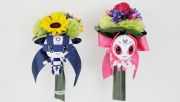TOKYO 2020: Experts reveal the meaning behind the victory bouquets
At the Tokyo 2020 Olympics and Paralympics medalists are awarded with a victory bouquet and Interflora reveal the deeper meaning behind the chosen flowers.
All of the flowers used for the bouquets for Tokyo 2020 are grown mainly in areas affected by the Great East Japan Earthquake in 2011 and the Olympic and Paralympic games present a vital opportunity to promote these areas to a worldwide audience. There will be over 5,000 victory bouquets presented to medalists from all over the world throughout the Olympic and Paralympic games and photographs of them will stay alive in the hands of winning athletes forever.
Additionally, each bouquet will include either the Olympic or Paralympic mascot, a token or keepsake athletes can take home with them long after they keep their bouquets.
The meaning behind each flower
Vicky Salmon, head florist at Interflora comments, 'The beautiful bouquets being presented to the medalists at Tokyo 2020 have a deeper meaning and have been chosen carefully by the Olympic organisers in Japan. The victory bouquets include eustomas and Solomon’s seals which have been grown in Fukushima, sunflowers from Miyagi, gentians from Iwate, and aspidistras from Tokyo. The organisers have also spent time on the arrangement itself, with all flowers being arranged in a balanced way so each of the flowers can be seen from whichever angle the athletes hold them at during their celebrations.
The flowers have been cut with shorter stems and sit within a small bag of water in gel form to keep them fresh for as long as possible. This method should allow the flowers to stay beautiful for around 7 days.'
According to the Olympic committee, the Japanese organisers have chosen each flower for a specific reason:
The eustomas have been grown and produced in the prefecture of Fukushima, which was drastically affected by the Great East Japan Earthquake and subsequent nuclear disaster. After the agricultural industry was halted and destroyed Fukushima established a non-profit organisation to grow flowers in a bid to fuel the hope of recovery.
The sunflowers used have been grown in Miyagi. Parents who lost children to the earthquake returned to the area to plant sunflowers on the hill where children sought safety from the tsunami. As such the hill becomes covered with sunflowers every year and the yellow flower has become a symbol for the people of Miyagi who were affected by the disaster in 2011.
Iwate Prefecture is widely known for its production of gentians, which make up the third flower included in the bouquet. Over half of the gentians produced in Japan come from Iwate, making it synonymous with the region, additionally, its Indigo blue colour is the same as the Tokyo 2020 Games emblem making it even more symbolic for the games.
Finally, aspidistras make up the final flower in the bouquet. These flowers have been grown in the host city of Tokyo and place the home of the 2020 Olympics right into the hands of the athletes who succeed there.
The Tokyo 2020 mascots
Both the Olympic and Paralympic mascots have also been included in the bouquets, with medalists receiving a small version of them attached to the victory flowers.
The Olympic mascot MIRAITOWA has been chosen to represent both Japans tradition and its future. The name is based on the Japanese words "mirai", meaning “future”, and "towa", meaning “eternity”.
The Paralympic mascot has been chosen due to its representation of strength. The name SOMEITY comes from "Someiyoshino" — a popular type of cherry blossom — and the phrase "so mighty". SOMEITY can show enormous mental and physical strength, representing Paralympic athletes who overcome obstacles and redefine the boundaries of possibility.



